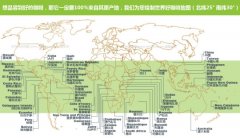Common sense of grading coffee beans in coffee producing areas of Brazil
Compared with other producing countries in Central and South America, Brazil is significantly lower, with a larger proportion of estates less than 1000 meters. The flat and monotonous landform, lack of micro-climate, and accustomed to unshaded tree (sun-exposed) planting have developed Brazil's unique soft bean flavor-low sour taste, high nutty flavor, good chocolate sweetness and mellowness, but slightly woody and earthy flavor, flower and orange fragrance is not obvious. To put it simply, Brazilian coffee is relatively light, and it is not easy to drink the sour and orange aromas of wild African beans.
Brazilian coffee interprets the aesthetics of soft beans in five levels, in the following order: strictlySoft (strictlySoft), → (soft), Softish (Softish), → (Hardish) and Rioy (iodine). In other words, Brazilian beans do not emphasize the lively acidity, rhythm and transparency of hard beans, but focus on the mild, smooth, mellow and sweet characteristics of soft beans, so Brazilian beans are the most suitable formula for espresso.
According to this standard, the producing areas of Brazil can also be divided into five grades:
Extremely meek: South Minas, Serrado platform in the central and western part of Minas / Mojiana / Bahia Diamond Plateau in northeastern Sao Paulo province
Supple: slightly higher in Bahia / Minas southeast forest / Parana / San Espiritu (mausoleum) / central and western S ã o Paulo
A little softer: East and northeast of Minas
Not easy to read: Espiritu Santo / Parana (low altitude)
Iodine choking: slightly lower southeast of Minas / Espiritu Santo (flat)

Important Notice :
前街咖啡 FrontStreet Coffee has moved to new addredd:
FrontStreet Coffee Address: 315,Donghua East Road,GuangZhou
Tel:020 38364473
- Prev

Common sense of blending coffee beans
People need to put coffee from different places together for several different purposes. The ideal goal, of course, is to piece together a coffee that tastes better than any of them. But generally speaking, Arabica coffee from a single origin is enough to make coffee that tastes good for export; it has a delicate flavor, a soft taste and a sweet aftertaste. So there is no need to match (that is, different places of origin
- Next

Common sense of coffee beans world-famous individual coffee beans and their origin
Latin American coffee beans (Central and South America) Brazil: Santos, Bahia, Cerrado, Mogiana Mexico: Coatepec, Huatusco, Orizaba, Maragogype, Tapanchula, Huixtla, Plumako
Related
- Guji coffee producing area of Guji, Ethiopia: Humbela, Shakiso, Wulaga
- What is the most expensive variety of Qiloso in BOP multi-variety group?
- How to store the coffee beans bought home?
- Why are Yemeni coffee beans so rare now?
- Ethiopian Sidamo all Red Fruit Sun Sun Santa Vini Coffee beans
- SOE is mostly sour? What does it mean? Is it a single bean? what's the difference between it and Italian blending?
- Is Italian coffee beans suitable for making hand-brewed coffee?
- How to choose coffee beans when making cold coffee? What kind of coffee beans are suitable for making cold coffee?
- Just entered the pit to make coffee, what kind of coffee beans should be chosen?
- Can only Japan buy real Blue Mountain Coffee? What are authentic Jamaican Blue Mountain coffee beans?

